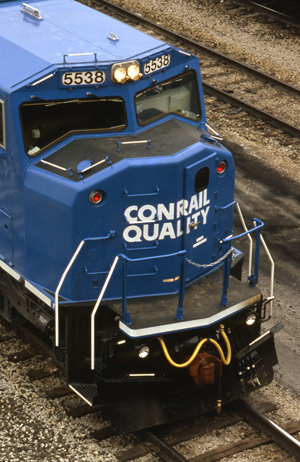Home ← Steam Railroads ← Rebuilding 1980-2000
Rebuilding the Railroads
1980-2000
The 1980s brought the implementation of the Staggers Act which along with the Railroad Revitalization and Regulatory Reform Act of 1976 allowed the railroads to set their own rates thus becoming competitive with trucking and each other. It also made it easier to abandoned or sell redundant lines leading to the rise of the regional railroads. The Class I railroads with their union contracts could make a profit by handling large trains carrying bulk commodities over long distances. The regional lines with their non-union workers and relaxed work rules could make a profit handling switching, short haul and terminal traffic. (See Note 1 below) 
Click to enlarge
Conrail born out of the ashes of the Penn Central bankruptcy grew into a well-respected,well managed railroad with a professional dedicated workforce.During the 1980s and 1990s the Class I railroads invested heavily in new motive power and capital improvements to their infrastructure. Older diesel locomotives were sold off to the regional railroads. Railroads became a more popular investment on Wall Street.
The Pennsylvania Railroad’s Cleveland Akron & Columbus and Bradford lines were abandoned. The Chessie System became CSX and the Norfolk & Western became the Norfolk Southern.
Columbus has its regional railroads as well. The PRR’s Columbus-Mingo Jct. became the Ohio Central Railroad. The Indiana & Ohio Railway took over the Hocking Valley’s Columbus – Logan line as well as the B&O’s Columbus to Midland City line. The Camp Chase Industrial Railroad operated the track between Buckeye Yard and Lilly Chapel just west of Columbus. (See Note 2 below)
During the 1980s many familiar railroad buildings like towers, depots and maintenance buildings disappeared as they were torn down or sold to save on real estate taxes. The abandoned PRR shops and yards on the eastside of Columbus became the right of way for I-670. The New York Central’s West Columbus Yard became the COTA bus garage.
The final change before the turn of the Century, in 1999, was the Conrail split between CSX and Norfolk Southern.
Through the lens of the camera the reader will see signs of the improvement to the railroads in Columbus during the last 20 years of the Twentieth-Century.
------------------------------------
NOTE 1 - The Railroad Revitalization and Regulatory Reform Act of 1976 (often called the "4R Act"), reduced federal regulation of railroads and authorized implementation details for Conrail, the new northeastern railroad system. The 4R reforms included allowance of a greater range for railroad pricing without close regulatory restraint, greater independence from collective rate making procedures in rail pricing and service offers, contract rates, and, to a lesser extent, greater freedom for entry into and exit from rail markets. The 4R Act set the stage for most of what occurred after Staggers was passed by Congress.
NOTE 2 - Conrail was in the process of abandoning the Columbus-Pittsburgh portion of the Panhandle Line and managed to cut the portion between Mingo Jct. and Pittsburgh. Local communities and shippers along the remainder of the line organized and pushed the state into buying the line and leasing to the Ohio Central Railroad (now Genesee & Wyoming owned).
One downside of the Staggers Act is that the railroad's downsized or eliminated rail corridors. But when the economy turned around and shipping demand increased, the Class-1's were caught with not enough infrastructure and equipment to handle the demand. It was so bad, that Union Pacific and Conrail lost a lot of business from UPS. That forced a major rebuilding effort by the railroads to restore trackage to some downsized corridors, including the east-west CSX corridor through Ohio and Conrail's "Water Level" route along Lake Erie.